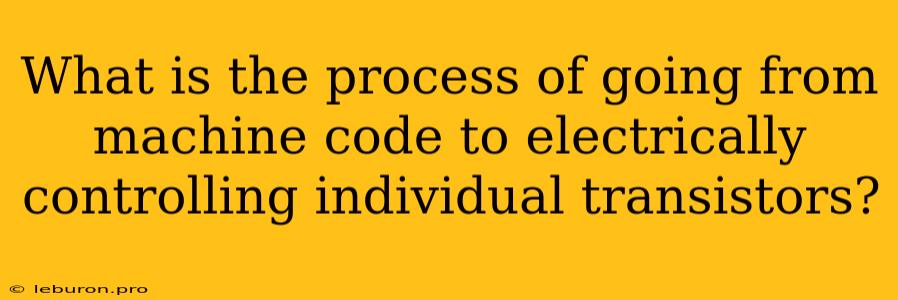The journey from abstract machine code to the physical manipulation of transistors within a computer is a complex and fascinating process that bridges the gap between human instructions and the intricate workings of electronics. This transformation involves multiple stages, each relying on specialized tools and techniques to translate the digital world into the language of electrical signals. It is a process that highlights the remarkable ingenuity of computer scientists and engineers in harnessing the power of transistors to execute our digital commands.
From Machine Code to Electrical Signals: A Deep Dive
At the heart of this journey lies the machine code, a sequence of binary digits (0s and 1s) that represents the instructions a computer can understand. These instructions, in their raw form, are not directly capable of controlling transistors. Instead, they require a series of transformations to become meaningful signals that can be interpreted by the intricate circuitry within a computer.
1. The Assembler: Bridging the Gap
The first step in this transformation is typically handled by an assembler, a program that translates assembly language into machine code. Assembly language is a low-level programming language that provides a more human-readable representation of machine instructions. Each instruction in assembly language corresponds directly to a specific machine code operation. For example, an assembly instruction might tell the computer to "add the value in memory location 10 to the value in register 2." The assembler then translates this instruction into a specific sequence of binary digits that the computer can execute.
2. The Compiler: From High-Level Languages to Machine Code
For most programmers, writing directly in assembly language is a tedious and error-prone process. Instead, they often use high-level programming languages, such as C++, Python, or Java, which provide a more abstract and human-friendly way to express instructions. To bridge the gap between high-level languages and machine code, a compiler is used.
A compiler takes the code written in a high-level language and translates it into equivalent machine code. This process involves several stages, including:
- Lexical Analysis: Breaking the code down into individual units called tokens (e.g., keywords, identifiers, operators).
- Parsing: Building a tree-like representation of the code's structure, known as a parse tree.
- Semantic Analysis: Ensuring the code follows the rules of the programming language and has logical meaning.
- Intermediate Code Generation: Creating an intermediate representation of the code that is easier for the compiler to optimize.
- Code Optimization: Making the code more efficient by removing redundant instructions or rearranging code for better performance.
- Code Generation: Producing the final machine code that the computer can execute.
3. The Microcontroller: Decoding Instructions and Controlling Transistors
The machine code generated by the assembler or compiler is then loaded into the computer's memory. The microcontroller, a specialized chip within the computer, acts as the interpreter, reading the machine code instructions and translating them into electrical signals. This translation is accomplished through a combination of decoders and control logic.
- Decoders: These circuits interpret the machine code instructions and generate specific control signals for the various components within the computer.
- Control Logic: This logic determines the sequence of operations that need to be performed to execute an instruction.
The control signals from the microcontroller then travel to the various transistors, which act as the basic building blocks of the computer's circuitry. By switching between on and off states, transistors control the flow of electrical current within the computer, carrying out the instructions encoded in the machine code.
4. Transistors: The Foundation of Computation
Transistors are semiconductor devices that act as electronic switches. They are essential components in all modern computers, enabling the processing, storage, and transmission of information.
Transistors work by controlling the flow of electrical current through a small piece of semiconductor material. By applying a small voltage to the gate of a transistor, we can turn it on or off, allowing or blocking the flow of current between the source and drain terminals.
This switching capability forms the basis of digital logic, allowing transistors to represent binary values (0 or 1). By combining multiple transistors in different configurations, we can build complex logic circuits that can perform various operations, such as addition, subtraction, and comparison.
5. From Electrical Signals to Physical Results
The electrical signals generated by the transistors are then used to manipulate data within the computer. For example, in a memory circuit, transistors can be used to store data as electrical charges on capacitors. In a processing unit, transistors can be used to perform calculations by manipulating electrical signals in specific ways. Finally, in output devices like displays or speakers, the electrical signals are converted into physical phenomena that humans can perceive.
The Importance of Understanding the Process
Understanding the process of going from machine code to electrically controlling individual transistors is fundamental to comprehending how computers work. This knowledge provides insights into the inner workings of computer systems, empowering programmers to write more efficient and effective code. It also sheds light on the remarkable technological advancements that have made modern computers so powerful and versatile.
The journey from abstract code to tangible results is a testament to the ingenuity of computer science and engineering. By bridging the gap between the digital world and the physical world, this process enables us to harness the power of transistors to create complex and transformative technologies that continue to shape our lives.
